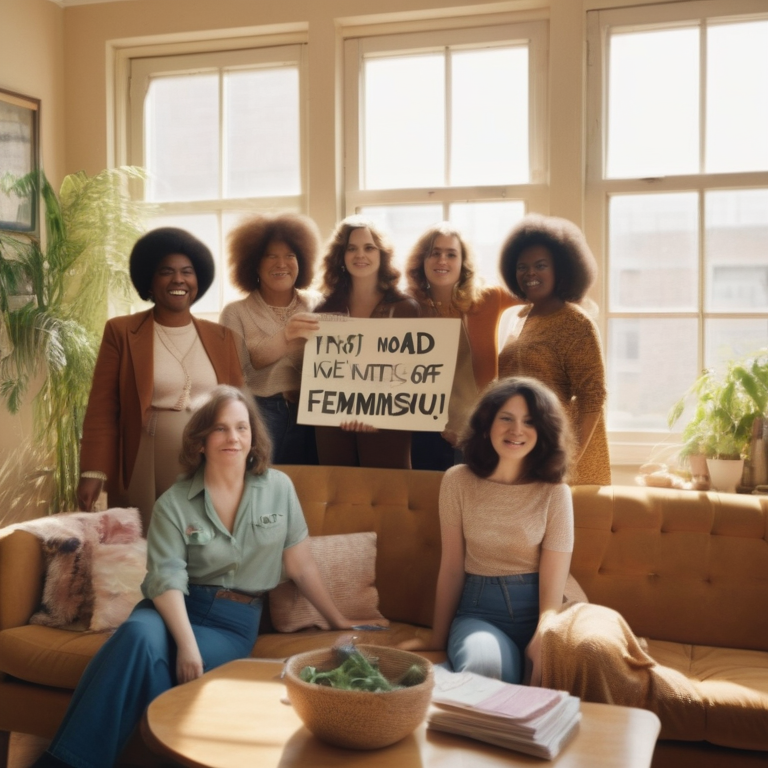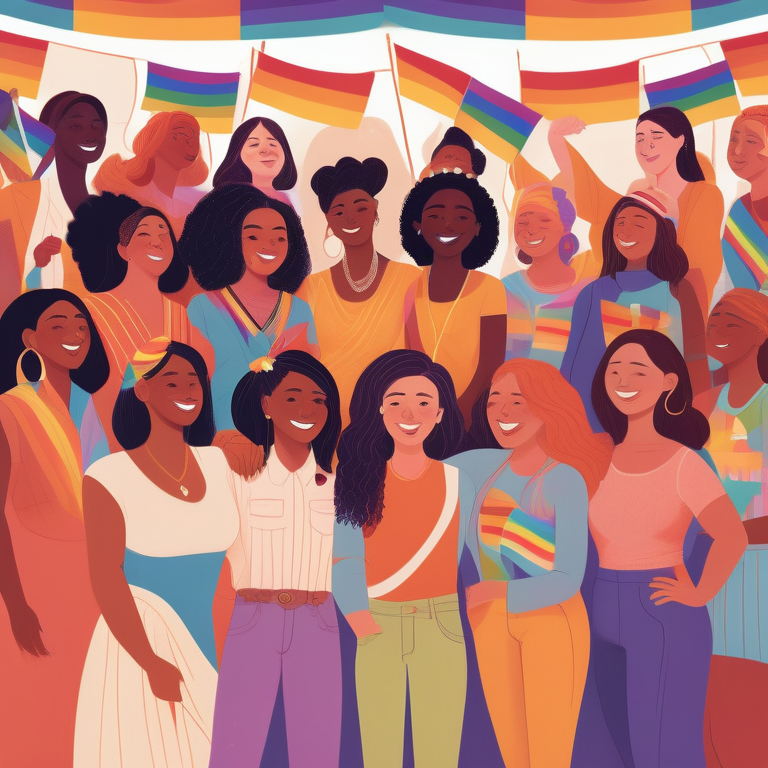Exploring Second-Wave Feminism and Sexuality
What were the main goals of Second-Wave Feminism in relation to sexuality?
Second-Wave Feminism aimed to address sexual and reproductive rights, combat sexual violence and discrimination, and challenge traditional gender roles and stereotypes. It sought to empower women in making choices about their bodies and sexuality and promote equality in all aspects of intimate relationships.

Key Highlights
- The second wave feminism movement took place in the 1960s and 1970s, focusing on issues of equality and discrimination.
- Second wave feminism was characterized by a united goal of social equality, with sexuality and reproductive rights being central concerns.
- Major achievements of second wave feminism include the approval of the contraceptive pill, the right for women to hold credit cards and mortgages, and the outlawing of marital rape.
- The second wave feminism movement faced challenges such as internal divisions and external opposition, but it had a lasting impact on modern sexuality.
- Literature, media, and the LGBTQ+ rights movement played significant roles in shaping and influencing second wave feminism and its views on sexuality.
- The legacy of second wave feminism includes lasting changes in laws and social norms, but there are still areas in need of progress in modern society.
Introduction
The second wave feminism movement emerged in the 1960s and 1970s, building upon the foundation laid by the first wave of feminism in the early 20th century. It focused on issues of equality and discrimination, challenging societal norms and advocating for women’s rights. The second wave was characterized by a more widespread and diverse movement, encompassing not only suffrage but also reproductive rights, sexual liberation, and social equality. This blog explores the roots and achievements of second wave feminism, with a particular focus on its impact on women’s sexuality and the history of feminism.
The Roots of Second-Wave Feminism
The second wave feminism movement originated in the United States and quickly spread to other Western countries. It emerged in the context of the civil rights movement and the anti-war movement, with activists recognizing that women’s cultural and political inequalities were interconnected. The feminist movement gained momentum with the publication of Betty Friedan’s book “The Feminine Mystique” in 1963, which challenged traditional gender roles and sparked a call for women’s liberation and the women’s movement at the end of the 20th century.
Historical Context and Key Figures
The second wave feminism movement unfolded against the backdrop of the civil rights movement and the women’s movement. The fight for racial equality and the demand for women’s rights were intertwined, as activists recognized the intersecting nature of oppressions. Key figures in the second wave feminism movement include Betty Friedan, author of “The Feminine Mystique,” Gloria Steinem, a prominent feminist and journalist, Germaine Greer, whose book “The Female Eunuch” challenged traditional notions of femininity, and African American women such as Angela Davis and Audre Lorde, who fought for the rights of both women and people of color. These figures, along with many others, contributed to the discourse and activism that shaped the second wave feminism movement.
Major Achievements and Legislation
The second wave feminism movement achieved significant milestones in the fight for women’s rights. One of the major achievements was the approval of the contraceptive pill by the Food and Drug Administration in 1960, which gave women greater control over their reproductive rights. Within five years, around 6 million women were using the pill. Feminists also worked towards securing legal protections for women, such as the right to hold credit cards and apply for mortgages in their own name. Marital rape was outlawed, and awareness around domestic violence was raised. Legislative victories included the passing of the Equal Pay Act in 1963, Title IX in 1972, and Roe v. Wade in 1973, which legalized abortion and birth control in the United States and paved the way for greater access to health care for women.
Understanding Women’s Sexuality in the Second Wave
Women’s sexuality was a central concern in the second wave feminism movement. It challenged societal attitudes towards women’s sexuality, including sexual orientation and body image. The movement aimed to empower women to embrace their own desires and break free from traditional gender roles and expectations. It sought to challenge and dismantle harmful stereotypes and create space for women to express their own sexual identities and experiences, including sexual attraction.
Societal Attitudes Towards Women’s Sexuality Pre-Second Wave
Before the second wave feminism movement, societal attitudes towards women’s sexuality were often restrictive and based on traditional gender roles. Women were expected to conform to certain ideals of beauty and behavior, and their sexuality was often viewed as secondary to male pleasure. American women in particular faced social and cultural pressures that limited their sexual autonomy. The second wave feminism movement sought to challenge these attitudes and provide a platform for women to assert their sexual desires and agency.
Shifts in Perception Post-Second Wave
The second wave feminism movement brought about significant shifts in societal perception of women’s sexuality. It emphasized the importance of sexual health, pleasure, and body image. The movement encouraged women to prioritize their own desires and needs in sexual encounters and to reject harmful societal expectations. It challenged the notion that women’s sexuality should be solely for the pleasure of men and advocated for sexual liberation and exploration. These shifts in perception paved the way for conversations around sexual pleasure, consent, and the importance of women’s agency in sexual relationships with their sexual partners, highlighting the importance of discussing women’s sexuality and related health issues in order to fully understand and embrace the concept of women’s sexual liberation.
Sexual Liberation Movement
The sexual liberation movement emerged alongside the second wave feminism movement, particularly in cities like New York. It advocated for sexual freedom and the dismantling of traditional sexual norms and taboos. The movement sought to challenge societal restrictions on sexuality and promote sexual exploration and expression. It was closely intertwined with the feminist movement and played a significant role in shaping attitudes towards women’s sexuality.
Key Events and Protests
The sexual liberation movement was marked by key events and protests that aimed to challenge societal norms and promote sexual freedom. Some notable events include:
- The Stonewall riots in 1969, which marked a turning point in the gay rights movement and ignited a broader movement for sexual liberation.
- The Women’s Liberation Movement’s protests against the Miss America pageant in 1968, which highlighted the objectification and mistreatment of women in mainstream society.
- The establishment of women’s health clinics and organizations focused on reproductive rights, such as Planned Parenthood.
These events and protests contributed to the broader social movements of the time and helped shape the discourse around women’s sexuality and liberation.
Impact on Women’s Sexual Freedom
The sexual liberation movement had a profound impact on women’s sexual freedom. It challenged societal norms and expectations around sexual behavior, desire, and expression. The movement encouraged women to explore their own desires and to prioritize their own pleasure in sexual encounters, ultimately shaping their sexual experience. It also played a role in destigmatizing discussions around topics such as contraception, abortion, and sexual health. By advocating for sexual freedom and autonomy, the movement empowered women to assert their own agency and challenge traditional gender roles and expectations in the realm of sexuality, including the ability to fulfill their sexual urges outside of marriage. This movement also highlighted the impact of societal and religious attitudes on sexual attitudes, and how they can affect an individual’s sense of sexual expression and freedom.
The Role of Literature and Media
Literature and media played influential roles in shaping societal perceptions of women’s sexuality during the second wave feminism movement. They both reflected and influenced popular culture and helped shape public discourse around gender, sexuality, and women’s rights. Many influential works and authors emerged during this time, exploring themes of female sexuality, empowerment, and liberation. The representation of women and their sexuality in literature and media became a subject of critical examination and critique, contributing to the broader conversations around gender equality, sexual liberation, mental health, and the role of media in shaping societal perceptions.
Influential Works and Authors
During the second wave feminism movement, numerous influential works and authors emerged, contributing to the discourse on women’s sexuality and empowerment. Some notable works include:
- “The Feminine Mystique” by Betty Friedan, which challenged traditional gender roles and sparked a call for women’s liberation.
- “The Female Eunuch” by Germaine Greer, which critically examined the societal pressures placed on women and advocated for sexual liberation.
- “Fear of Flying” by Erica Jong, which explored female sexuality and desire in a frank and candid manner.
These works, along with many others, became foundational texts in women’s studies and played a significant role in shaping the feminist movement’s understanding of women’s sexuality.
Media Representation of Women and Sexuality
Media representation of women and their sexuality played a significant role in shaping societal attitudes during the second wave feminism movement. Popular culture, including movies, television, and advertising, often perpetuated harmful stereotypes and objectification of women. However, the feminist movement and its critique of media representation helped challenge these norms and paved the way for more diverse and empowering portrayals of women. Gender studies, including women’s studies, emerged as an academic discipline, examining the intersection of gender, media, and society. The analysis of media representation in relation to women’s sexuality continues to be an important area of study and activism, as it influences societal attitudes and perceptions and is a key component of women’s studies.
Feminism and LGBTQ+ Rights
The second wave feminism movement had a significant impact on LGBTQ+ rights and the broader discourse on gender equality. It recognized the importance of intersectionality, understanding that gender intersects with other social identities such as race, sexuality, and class. Feminists during this time advocated for the rights of LGBTQ+ individuals and their inclusion within the feminist movement, including issues such as health care. The fight for gender equality was seen as interconnected with the fight for LGBTQ+ rights, recognizing the shared struggles and goals in challenging societal norms and discrimination.
Intersectionality with the Gay Rights Movement
The second wave feminism movement and the gay rights movement intersected, recognizing the shared struggles and goals in challenging societal norms and discrimination. The fight for gender equality and LGBTQ+ rights were seen as interconnected, as both movements aimed to challenge and dismantle oppressive systems. The gay rights movement drew inspiration from the feminist movement’s advocacy for social equality and its critique of traditional gender roles. The recognition of intersectionality, which acknowledges the ways in which different forms of oppression intersect and compound one another, further strengthened the relationship between the two movements. This intersectionality helped shape the broader discourse on gender and sexuality, paving the way for more inclusive and intersectional approaches to activism and social change.
Contributions to Broader Sexual Rights Discourses
The second wave feminism movement made significant contributions to broader discourses on sexual rights. By challenging societal norms and advocating for sexual liberation, feminists expanded the understanding of sexual rights and autonomy. The movement pushed for the recognition of sexual pleasure, consent, and reproductive rights as fundamental human rights. It also played a pivotal role in destigmatizing discussions around topics such as contraception, abortion, and sexual health. The feminist movement’s contributions to sexual rights discourses continue to shape the broader understanding of sexuality and inform ongoing conversations around reproductive justice, comprehensive sex education, and the right to sexual autonomy.
Challenges and Criticisms
The second wave feminism movement faced challenges and criticisms from both within and outside the movement. Internal divisions were present, with differing ideologies and approaches to activism. Radical feminism, in particular, sought to completely restructure society and faced criticism for its radical methods. External opposition and misconceptions also posed challenges, with some individuals and groups opposing feminist goals and misrepresenting the movement’s aims. These challenges and criticisms, while significant, did not diminish the impact and achievements of the second wave feminism movement.
Internal Divisions within the Movement
The second wave feminism movement encompassed a diverse range of voices and ideologies, leading to internal divisions within the movement. Radical feminism, in particular, emerged as a distinct ideology, seeking to completely restructure society and challenge traditional gender roles. This radical approach faced criticism and resistance from within the movement itself, as some feminists believed it was too extreme. These internal divisions, particularly among young women, led to debates and disagreements over the best strategies for achieving gender equality. Despite these divisions, the second wave feminism movement remained united in its goal of social equality, with sexuality and reproductive rights being central concerns. As the movement continues to evolve, a fourth wave of modern feminism is emerging, bringing new perspectives and challenges to the ongoing fight for gender equality.
External Opposition and Misconceptions
The second wave feminism movement faced external opposition and misconceptions from various individuals and groups. Some individuals opposed feminist goals, viewing them as a threat to traditional gender roles and societal norms. Misconceptions and stereotypes about feminists were widespread, often portraying them as man-haters or radical extremists. These misconceptions and opposition shaped public perception and created challenges for the movement. However, the second wave feminism movement was able to overcome these challenges and achieve significant advancements in women’s rights and societal attitudes towards gender and sexuality.
Legacy of Second-Wave Feminism on Modern Sexuality
The legacy of the second wave feminism movement continues to have a profound impact on modern sexuality. The movement’s achievements in promoting sexual freedom, challenging traditional gender roles, and advocating for reproductive rights have shaped societal attitudes and norms. The second wave feminism movement paved the way for more open discussions around sexuality, consent, and sexual pleasure. Its lasting legacy can be seen in the ongoing fight for gender equality and the recognition of sexual rights as fundamental human rights.
Lasting Changes in Laws and Social Norms
The second wave feminism movement brought about lasting changes in laws and social norms. Legislative victories, such as the passing of the Equal Pay Act, Title IX, and Roe v. Wade, have had a significant impact on women’s rights and gender equality. These legal changes have helped protect women from discrimination and ensure equal opportunities in various domains. Social norms have also shifted as a result of the feminist movement’s advocacy for sexual liberation and gender equality. Society’s understanding and acceptance of diverse sexual orientations and gender identities have expanded, challenging traditional norms and fostering a more inclusive and accepting culture.
Areas Still in Need of Progress
While the second wave feminism movement achieved significant advancements in women’s rights and gender equality, there are still areas in need of progress in modern society. Some of these areas include:
- Reproductive justice: Ensuring access to comprehensive reproductive healthcare and the right to make autonomous decisions about one’s own body.
- Intersectionality: Recognizing and addressing the intersecting forms of oppression faced by marginalized communities, including women of color, LGBTQ+ individuals, and those with disabilities.
- Rape culture and sexual violence: Challenging societal attitudes that perpetuate rape culture and working towards creating safe environments for all individuals.
- Gender-based violence: Combating domestic violence, sexual assault, and other forms of gender-based violence that disproportionately affect women.
These areas of need require ongoing activism and advocacy to achieve true gender equality and address the complex challenges that exist in modern society.
Conclusion
In reflecting on the impact of Second-Wave Feminism on sexuality, we uncover a profound shift in societal attitudes and legal frameworks that continue to shape our understanding today. The movement’s legacy extends beyond its time, influencing modern discussions on gender, sexual freedom, and LGBTQ+ rights. By exploring historical contexts, key achievements, and ongoing challenges, we honor the strides made while acknowledging areas where progress is still needed. As we navigate the complexities of gender equality and sexual rights, it is crucial to learn from the past and advocate for inclusivity and empowerment in all aspects of life. Share these insights on social media to spark meaningful conversations and promote awareness.
Frequently Asked Questions
How did second-wave feminism impact women’s rights to their own bodies?
The second wave feminism movement played a pivotal role in advancing women’s rights to their own bodies. It fought for reproductive rights, including access to safe and legal abortion and the right to make autonomous decisions about contraception and reproductive healthcare. The movement challenged societal norms and fought for women’s bodily autonomy, paving the way for greater control over their sexual and reproductive health.
How did second-wave feminism impact discussions around sexuality?
Second wave feminism opened up discussions around sexuality, challenging traditional norms and promoting sexual freedom and autonomy. It encouraged women to explore their desires, prioritize their pleasure, and challenge harmful stereotypes and expectations. These discussions continue to shape modern understandings of sexuality and empower individuals to embrace their own sexual identities and experiences.
What were some key events or movements within second-wave feminism related to sexuality?
Some key events and movements within second-wave feminism related to sexuality include the Women’s Liberation Movement’s protests against the Miss America pageant, which highlighted objectification and mistreatment of women, and the establishment of women’s health clinics and organizations focused on reproductive rights. These events and movements contributed to the broader discourse on sexual liberation and empowerment.
In what ways did second-wave feminism influence modern perspectives on gender and sexuality?
Second wave feminism influenced modern perspectives on gender and sexuality in various ways. It challenged traditional gender roles and norms, fostering a greater understanding of gender as a social construct. The movement’s emphasis on sexual liberation and discussions around consent and agency continue to shape modern understandings of sexuality and influence the fields of gender studies and feminist theory.





